Bilingual Education: Strategies for Multicultural Learning in Schools
VerifiedAdded on 2022/09/05
|15
|3670
|17
Essay
AI Summary
This essay delves into the multifaceted aspects of bilingual education within the context of a primary educational institution in the United Kingdom. It examines the presence of multiculturalism, the challenges faced by bilingual students, and the strategies employed by educators to foster an inclusive learning environment. The author presents observations from a school setting, analyzing how English is taught to non-native speakers and the measures taken to promote multiculturalism. Furthermore, the essay analyzes a policy document on multilingualism in Britain, highlighting the government's recognition of the importance of bilingualism for individual well-being and societal advancement. The essay underscores the significance of respecting students' cultural heritage and advocating for multilingual education to enhance students' development and prepare them for a globalized world. This assignment offers insights into the practical realities of bilingual education and the policies that shape it.
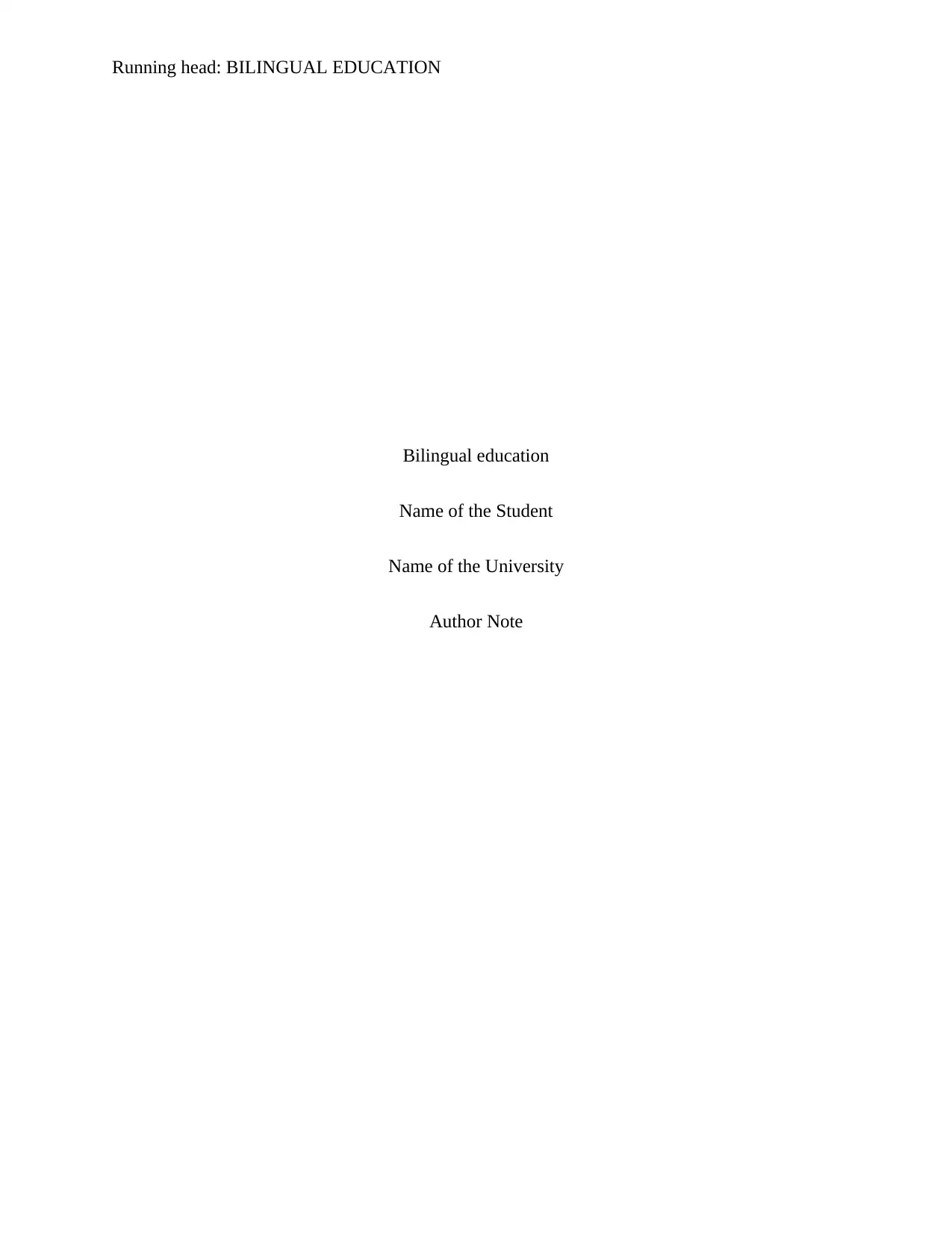
Running head: BILINGUAL EDUCATION
Bilingual education
Name of the Student
Name of the University
Author Note
Bilingual education
Name of the Student
Name of the University
Author Note
Paraphrase This Document
Need a fresh take? Get an instant paraphrase of this document with our AI Paraphraser
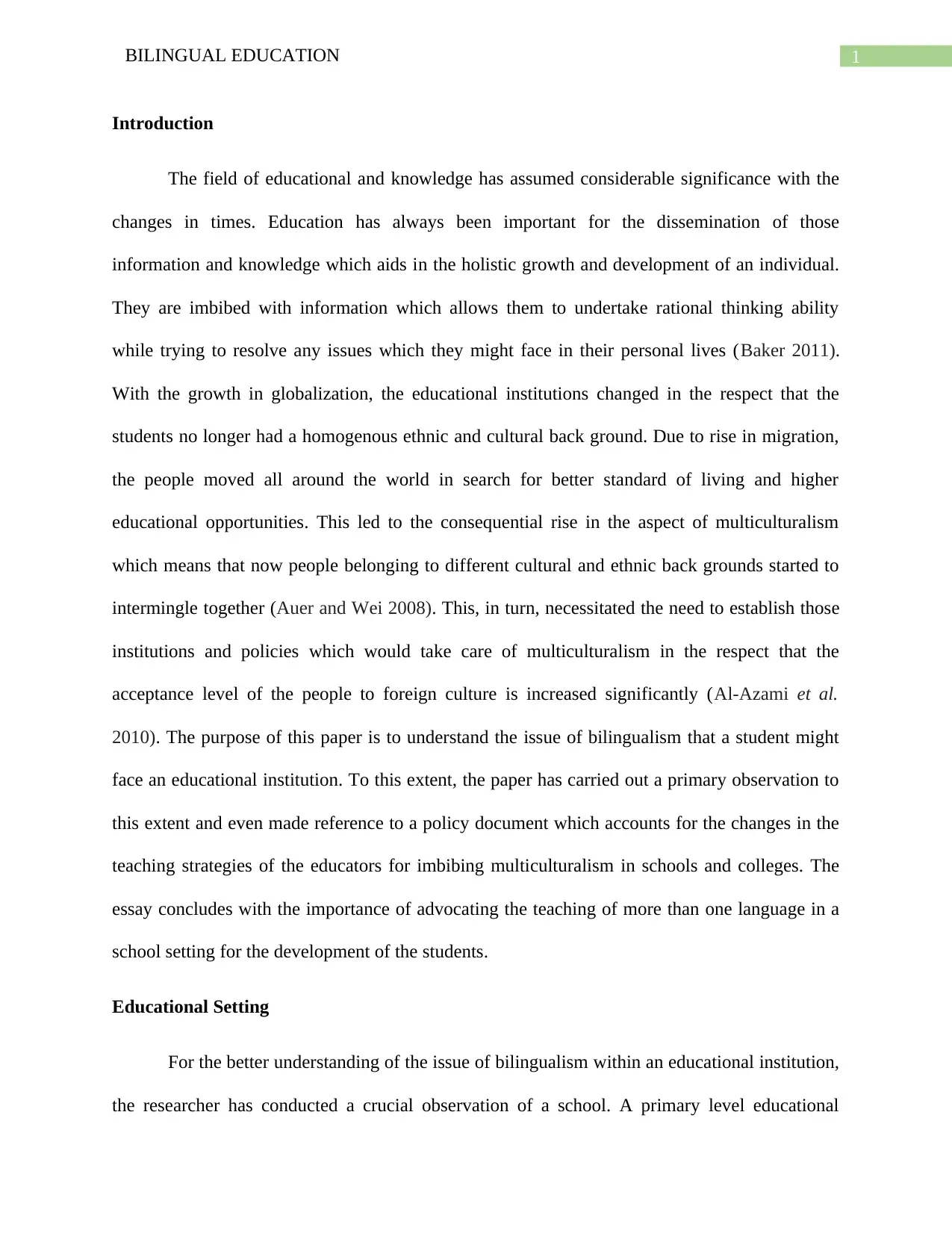
1BILINGUAL EDUCATION
Introduction
The field of educational and knowledge has assumed considerable significance with the
changes in times. Education has always been important for the dissemination of those
information and knowledge which aids in the holistic growth and development of an individual.
They are imbibed with information which allows them to undertake rational thinking ability
while trying to resolve any issues which they might face in their personal lives (Baker 2011).
With the growth in globalization, the educational institutions changed in the respect that the
students no longer had a homogenous ethnic and cultural back ground. Due to rise in migration,
the people moved all around the world in search for better standard of living and higher
educational opportunities. This led to the consequential rise in the aspect of multiculturalism
which means that now people belonging to different cultural and ethnic back grounds started to
intermingle together (Auer and Wei 2008). This, in turn, necessitated the need to establish those
institutions and policies which would take care of multiculturalism in the respect that the
acceptance level of the people to foreign culture is increased significantly (Al-Azami et al.
2010). The purpose of this paper is to understand the issue of bilingualism that a student might
face an educational institution. To this extent, the paper has carried out a primary observation to
this extent and even made reference to a policy document which accounts for the changes in the
teaching strategies of the educators for imbibing multiculturalism in schools and colleges. The
essay concludes with the importance of advocating the teaching of more than one language in a
school setting for the development of the students.
Educational Setting
For the better understanding of the issue of bilingualism within an educational institution,
the researcher has conducted a crucial observation of a school. A primary level educational
Introduction
The field of educational and knowledge has assumed considerable significance with the
changes in times. Education has always been important for the dissemination of those
information and knowledge which aids in the holistic growth and development of an individual.
They are imbibed with information which allows them to undertake rational thinking ability
while trying to resolve any issues which they might face in their personal lives (Baker 2011).
With the growth in globalization, the educational institutions changed in the respect that the
students no longer had a homogenous ethnic and cultural back ground. Due to rise in migration,
the people moved all around the world in search for better standard of living and higher
educational opportunities. This led to the consequential rise in the aspect of multiculturalism
which means that now people belonging to different cultural and ethnic back grounds started to
intermingle together (Auer and Wei 2008). This, in turn, necessitated the need to establish those
institutions and policies which would take care of multiculturalism in the respect that the
acceptance level of the people to foreign culture is increased significantly (Al-Azami et al.
2010). The purpose of this paper is to understand the issue of bilingualism that a student might
face an educational institution. To this extent, the paper has carried out a primary observation to
this extent and even made reference to a policy document which accounts for the changes in the
teaching strategies of the educators for imbibing multiculturalism in schools and colleges. The
essay concludes with the importance of advocating the teaching of more than one language in a
school setting for the development of the students.
Educational Setting
For the better understanding of the issue of bilingualism within an educational institution,
the researcher has conducted a crucial observation of a school. A primary level educational
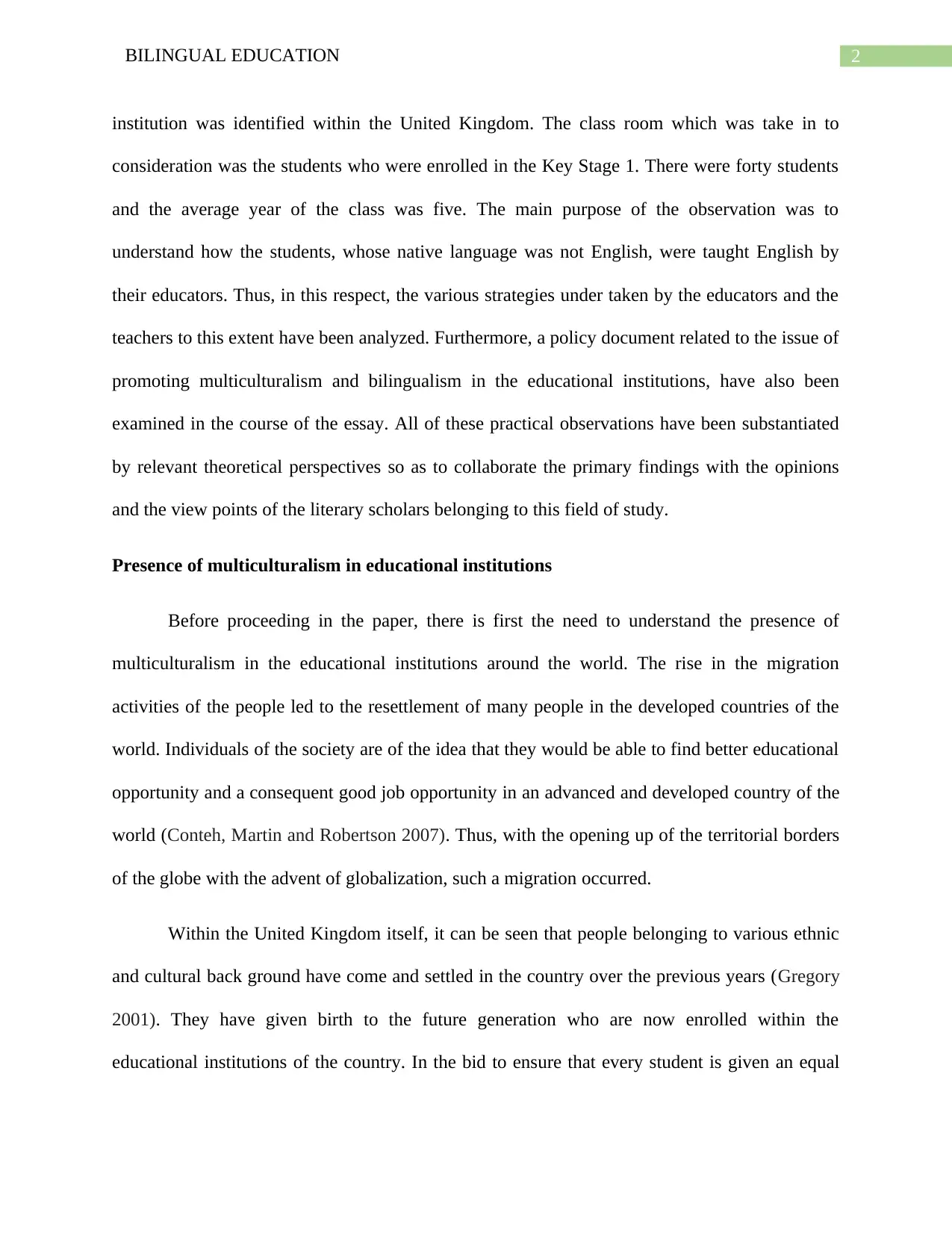
2BILINGUAL EDUCATION
institution was identified within the United Kingdom. The class room which was take in to
consideration was the students who were enrolled in the Key Stage 1. There were forty students
and the average year of the class was five. The main purpose of the observation was to
understand how the students, whose native language was not English, were taught English by
their educators. Thus, in this respect, the various strategies under taken by the educators and the
teachers to this extent have been analyzed. Furthermore, a policy document related to the issue of
promoting multiculturalism and bilingualism in the educational institutions, have also been
examined in the course of the essay. All of these practical observations have been substantiated
by relevant theoretical perspectives so as to collaborate the primary findings with the opinions
and the view points of the literary scholars belonging to this field of study.
Presence of multiculturalism in educational institutions
Before proceeding in the paper, there is first the need to understand the presence of
multiculturalism in the educational institutions around the world. The rise in the migration
activities of the people led to the resettlement of many people in the developed countries of the
world. Individuals of the society are of the idea that they would be able to find better educational
opportunity and a consequent good job opportunity in an advanced and developed country of the
world (Conteh, Martin and Robertson 2007). Thus, with the opening up of the territorial borders
of the globe with the advent of globalization, such a migration occurred.
Within the United Kingdom itself, it can be seen that people belonging to various ethnic
and cultural back ground have come and settled in the country over the previous years (Gregory
2001). They have given birth to the future generation who are now enrolled within the
educational institutions of the country. In the bid to ensure that every student is given an equal
institution was identified within the United Kingdom. The class room which was take in to
consideration was the students who were enrolled in the Key Stage 1. There were forty students
and the average year of the class was five. The main purpose of the observation was to
understand how the students, whose native language was not English, were taught English by
their educators. Thus, in this respect, the various strategies under taken by the educators and the
teachers to this extent have been analyzed. Furthermore, a policy document related to the issue of
promoting multiculturalism and bilingualism in the educational institutions, have also been
examined in the course of the essay. All of these practical observations have been substantiated
by relevant theoretical perspectives so as to collaborate the primary findings with the opinions
and the view points of the literary scholars belonging to this field of study.
Presence of multiculturalism in educational institutions
Before proceeding in the paper, there is first the need to understand the presence of
multiculturalism in the educational institutions around the world. The rise in the migration
activities of the people led to the resettlement of many people in the developed countries of the
world. Individuals of the society are of the idea that they would be able to find better educational
opportunity and a consequent good job opportunity in an advanced and developed country of the
world (Conteh, Martin and Robertson 2007). Thus, with the opening up of the territorial borders
of the globe with the advent of globalization, such a migration occurred.
Within the United Kingdom itself, it can be seen that people belonging to various ethnic
and cultural back ground have come and settled in the country over the previous years (Gregory
2001). They have given birth to the future generation who are now enrolled within the
educational institutions of the country. In the bid to ensure that every student is given an equal
⊘ This is a preview!⊘
Do you want full access?
Subscribe today to unlock all pages.

Trusted by 1+ million students worldwide
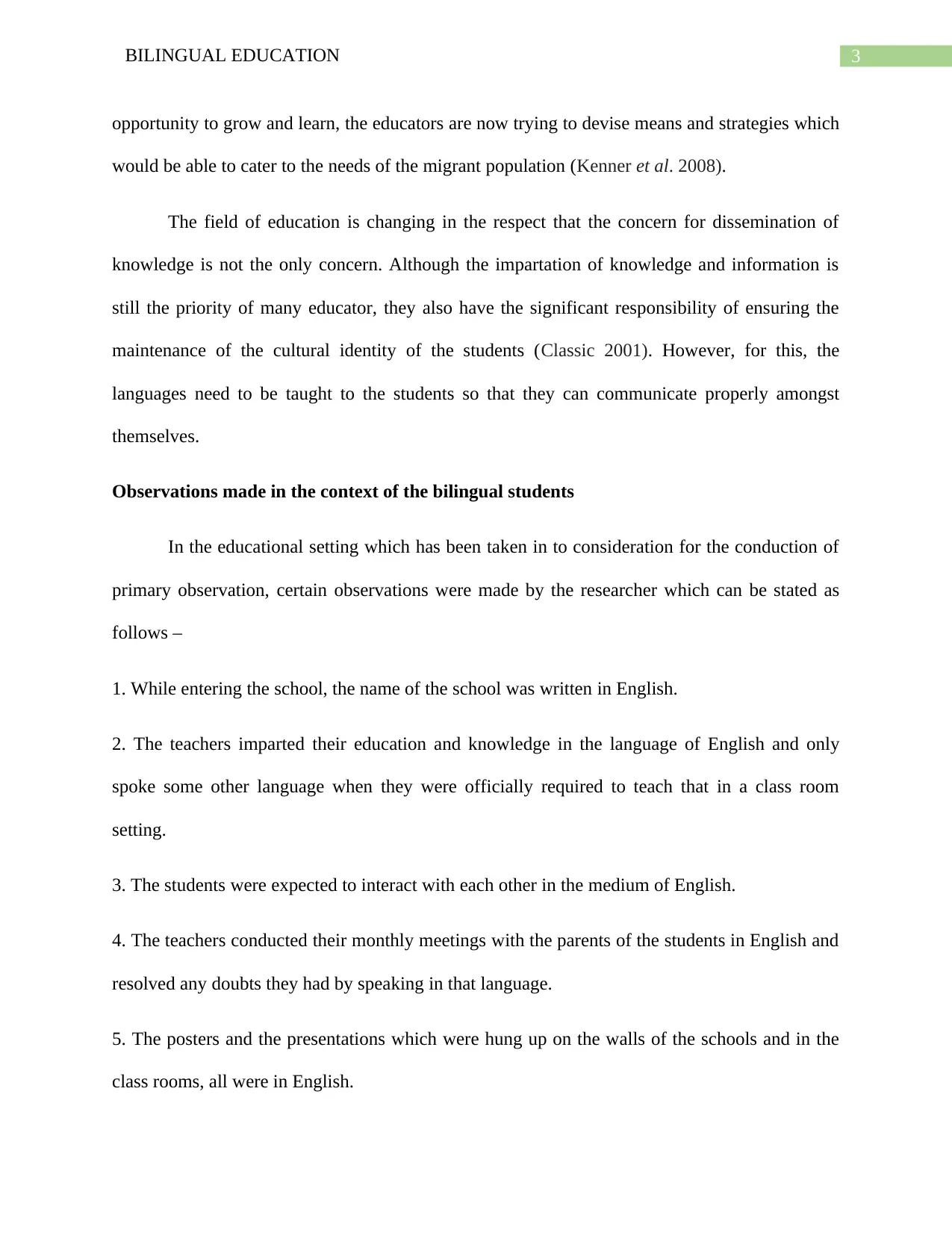
3BILINGUAL EDUCATION
opportunity to grow and learn, the educators are now trying to devise means and strategies which
would be able to cater to the needs of the migrant population (Kenner et al. 2008).
The field of education is changing in the respect that the concern for dissemination of
knowledge is not the only concern. Although the impartation of knowledge and information is
still the priority of many educator, they also have the significant responsibility of ensuring the
maintenance of the cultural identity of the students (Classic 2001). However, for this, the
languages need to be taught to the students so that they can communicate properly amongst
themselves.
Observations made in the context of the bilingual students
In the educational setting which has been taken in to consideration for the conduction of
primary observation, certain observations were made by the researcher which can be stated as
follows –
1. While entering the school, the name of the school was written in English.
2. The teachers imparted their education and knowledge in the language of English and only
spoke some other language when they were officially required to teach that in a class room
setting.
3. The students were expected to interact with each other in the medium of English.
4. The teachers conducted their monthly meetings with the parents of the students in English and
resolved any doubts they had by speaking in that language.
5. The posters and the presentations which were hung up on the walls of the schools and in the
class rooms, all were in English.
opportunity to grow and learn, the educators are now trying to devise means and strategies which
would be able to cater to the needs of the migrant population (Kenner et al. 2008).
The field of education is changing in the respect that the concern for dissemination of
knowledge is not the only concern. Although the impartation of knowledge and information is
still the priority of many educator, they also have the significant responsibility of ensuring the
maintenance of the cultural identity of the students (Classic 2001). However, for this, the
languages need to be taught to the students so that they can communicate properly amongst
themselves.
Observations made in the context of the bilingual students
In the educational setting which has been taken in to consideration for the conduction of
primary observation, certain observations were made by the researcher which can be stated as
follows –
1. While entering the school, the name of the school was written in English.
2. The teachers imparted their education and knowledge in the language of English and only
spoke some other language when they were officially required to teach that in a class room
setting.
3. The students were expected to interact with each other in the medium of English.
4. The teachers conducted their monthly meetings with the parents of the students in English and
resolved any doubts they had by speaking in that language.
5. The posters and the presentations which were hung up on the walls of the schools and in the
class rooms, all were in English.
Paraphrase This Document
Need a fresh take? Get an instant paraphrase of this document with our AI Paraphraser
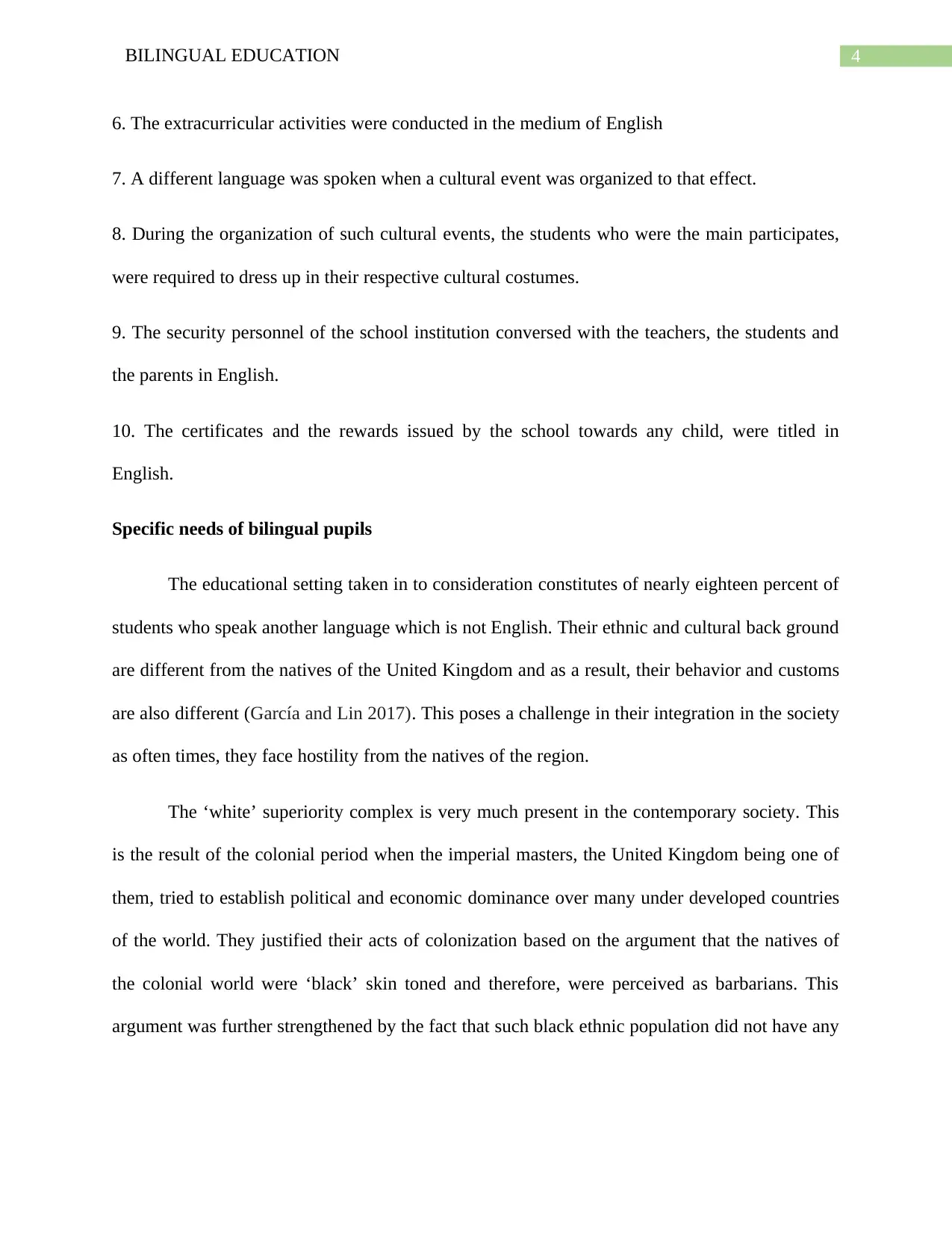
4BILINGUAL EDUCATION
6. The extracurricular activities were conducted in the medium of English
7. A different language was spoken when a cultural event was organized to that effect.
8. During the organization of such cultural events, the students who were the main participates,
were required to dress up in their respective cultural costumes.
9. The security personnel of the school institution conversed with the teachers, the students and
the parents in English.
10. The certificates and the rewards issued by the school towards any child, were titled in
English.
Specific needs of bilingual pupils
The educational setting taken in to consideration constitutes of nearly eighteen percent of
students who speak another language which is not English. Their ethnic and cultural back ground
are different from the natives of the United Kingdom and as a result, their behavior and customs
are also different (García and Lin 2017). This poses a challenge in their integration in the society
as often times, they face hostility from the natives of the region.
The ‘white’ superiority complex is very much present in the contemporary society. This
is the result of the colonial period when the imperial masters, the United Kingdom being one of
them, tried to establish political and economic dominance over many under developed countries
of the world. They justified their acts of colonization based on the argument that the natives of
the colonial world were ‘black’ skin toned and therefore, were perceived as barbarians. This
argument was further strengthened by the fact that such black ethnic population did not have any
6. The extracurricular activities were conducted in the medium of English
7. A different language was spoken when a cultural event was organized to that effect.
8. During the organization of such cultural events, the students who were the main participates,
were required to dress up in their respective cultural costumes.
9. The security personnel of the school institution conversed with the teachers, the students and
the parents in English.
10. The certificates and the rewards issued by the school towards any child, were titled in
English.
Specific needs of bilingual pupils
The educational setting taken in to consideration constitutes of nearly eighteen percent of
students who speak another language which is not English. Their ethnic and cultural back ground
are different from the natives of the United Kingdom and as a result, their behavior and customs
are also different (García and Lin 2017). This poses a challenge in their integration in the society
as often times, they face hostility from the natives of the region.
The ‘white’ superiority complex is very much present in the contemporary society. This
is the result of the colonial period when the imperial masters, the United Kingdom being one of
them, tried to establish political and economic dominance over many under developed countries
of the world. They justified their acts of colonization based on the argument that the natives of
the colonial world were ‘black’ skin toned and therefore, were perceived as barbarians. This
argument was further strengthened by the fact that such black ethnic population did not have any
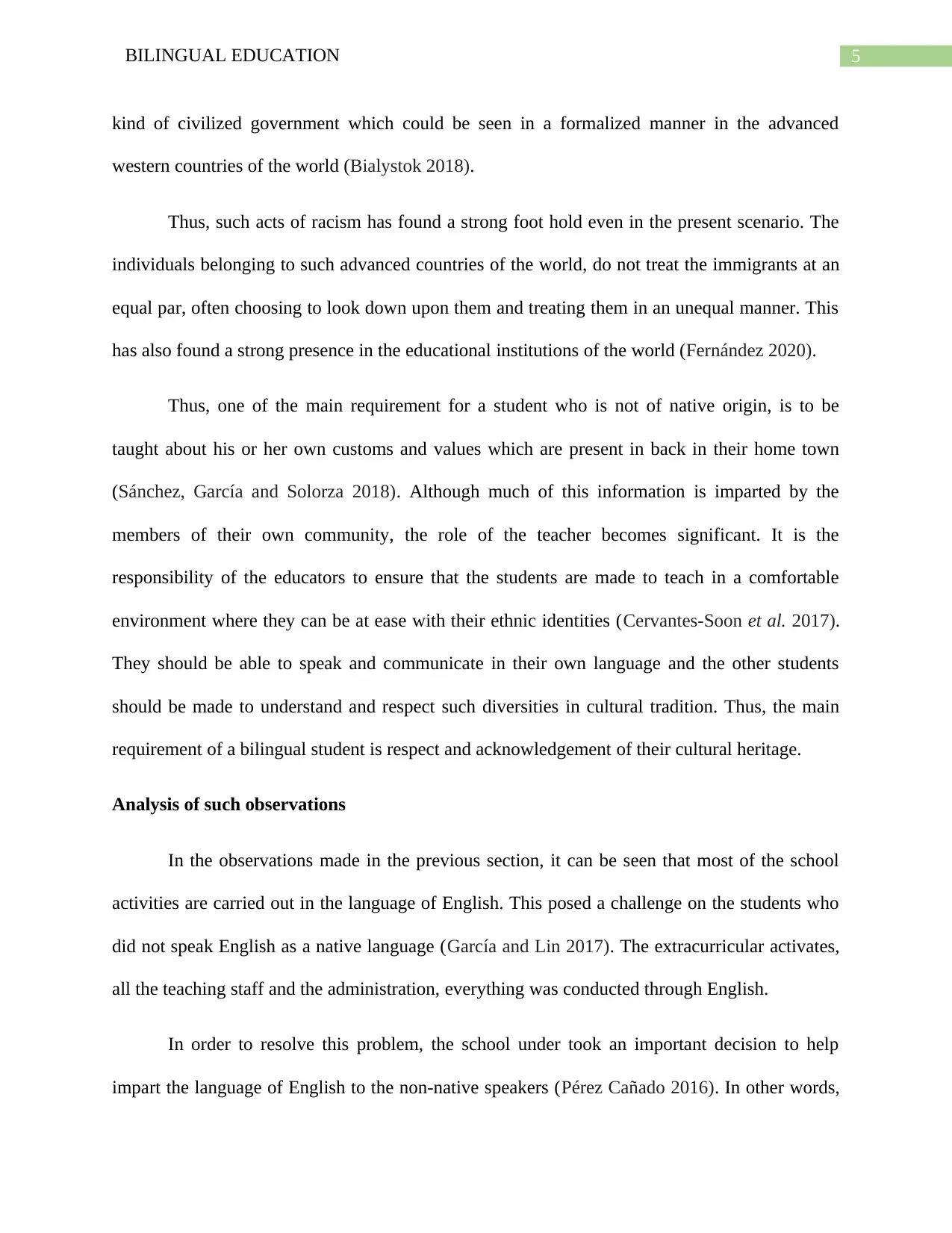
5BILINGUAL EDUCATION
kind of civilized government which could be seen in a formalized manner in the advanced
western countries of the world (Bialystok 2018).
Thus, such acts of racism has found a strong foot hold even in the present scenario. The
individuals belonging to such advanced countries of the world, do not treat the immigrants at an
equal par, often choosing to look down upon them and treating them in an unequal manner. This
has also found a strong presence in the educational institutions of the world (Fernández 2020).
Thus, one of the main requirement for a student who is not of native origin, is to be
taught about his or her own customs and values which are present in back in their home town
(Sánchez, García and Solorza 2018). Although much of this information is imparted by the
members of their own community, the role of the teacher becomes significant. It is the
responsibility of the educators to ensure that the students are made to teach in a comfortable
environment where they can be at ease with their ethnic identities (Cervantes-Soon et al. 2017).
They should be able to speak and communicate in their own language and the other students
should be made to understand and respect such diversities in cultural tradition. Thus, the main
requirement of a bilingual student is respect and acknowledgement of their cultural heritage.
Analysis of such observations
In the observations made in the previous section, it can be seen that most of the school
activities are carried out in the language of English. This posed a challenge on the students who
did not speak English as a native language (García and Lin 2017). The extracurricular activates,
all the teaching staff and the administration, everything was conducted through English.
In order to resolve this problem, the school under took an important decision to help
impart the language of English to the non-native speakers (Pérez Cañado 2016). In other words,
kind of civilized government which could be seen in a formalized manner in the advanced
western countries of the world (Bialystok 2018).
Thus, such acts of racism has found a strong foot hold even in the present scenario. The
individuals belonging to such advanced countries of the world, do not treat the immigrants at an
equal par, often choosing to look down upon them and treating them in an unequal manner. This
has also found a strong presence in the educational institutions of the world (Fernández 2020).
Thus, one of the main requirement for a student who is not of native origin, is to be
taught about his or her own customs and values which are present in back in their home town
(Sánchez, García and Solorza 2018). Although much of this information is imparted by the
members of their own community, the role of the teacher becomes significant. It is the
responsibility of the educators to ensure that the students are made to teach in a comfortable
environment where they can be at ease with their ethnic identities (Cervantes-Soon et al. 2017).
They should be able to speak and communicate in their own language and the other students
should be made to understand and respect such diversities in cultural tradition. Thus, the main
requirement of a bilingual student is respect and acknowledgement of their cultural heritage.
Analysis of such observations
In the observations made in the previous section, it can be seen that most of the school
activities are carried out in the language of English. This posed a challenge on the students who
did not speak English as a native language (García and Lin 2017). The extracurricular activates,
all the teaching staff and the administration, everything was conducted through English.
In order to resolve this problem, the school under took an important decision to help
impart the language of English to the non-native speakers (Pérez Cañado 2016). In other words,
⊘ This is a preview!⊘
Do you want full access?
Subscribe today to unlock all pages.

Trusted by 1+ million students worldwide
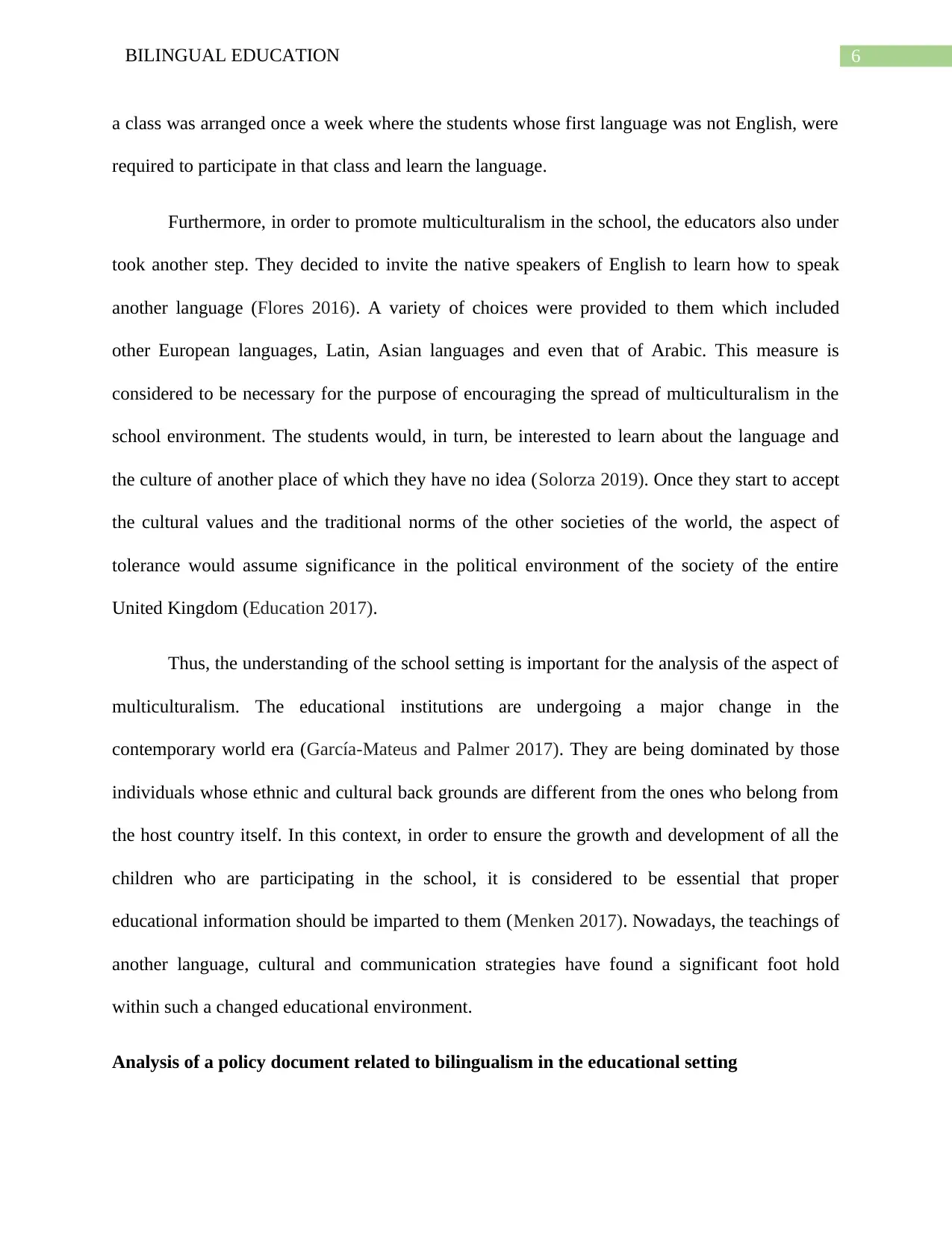
6BILINGUAL EDUCATION
a class was arranged once a week where the students whose first language was not English, were
required to participate in that class and learn the language.
Furthermore, in order to promote multiculturalism in the school, the educators also under
took another step. They decided to invite the native speakers of English to learn how to speak
another language (Flores 2016). A variety of choices were provided to them which included
other European languages, Latin, Asian languages and even that of Arabic. This measure is
considered to be necessary for the purpose of encouraging the spread of multiculturalism in the
school environment. The students would, in turn, be interested to learn about the language and
the culture of another place of which they have no idea (Solorza 2019). Once they start to accept
the cultural values and the traditional norms of the other societies of the world, the aspect of
tolerance would assume significance in the political environment of the society of the entire
United Kingdom (Education 2017).
Thus, the understanding of the school setting is important for the analysis of the aspect of
multiculturalism. The educational institutions are undergoing a major change in the
contemporary world era (García-Mateus and Palmer 2017). They are being dominated by those
individuals whose ethnic and cultural back grounds are different from the ones who belong from
the host country itself. In this context, in order to ensure the growth and development of all the
children who are participating in the school, it is considered to be essential that proper
educational information should be imparted to them (Menken 2017). Nowadays, the teachings of
another language, cultural and communication strategies have found a significant foot hold
within such a changed educational environment.
Analysis of a policy document related to bilingualism in the educational setting
a class was arranged once a week where the students whose first language was not English, were
required to participate in that class and learn the language.
Furthermore, in order to promote multiculturalism in the school, the educators also under
took another step. They decided to invite the native speakers of English to learn how to speak
another language (Flores 2016). A variety of choices were provided to them which included
other European languages, Latin, Asian languages and even that of Arabic. This measure is
considered to be necessary for the purpose of encouraging the spread of multiculturalism in the
school environment. The students would, in turn, be interested to learn about the language and
the culture of another place of which they have no idea (Solorza 2019). Once they start to accept
the cultural values and the traditional norms of the other societies of the world, the aspect of
tolerance would assume significance in the political environment of the society of the entire
United Kingdom (Education 2017).
Thus, the understanding of the school setting is important for the analysis of the aspect of
multiculturalism. The educational institutions are undergoing a major change in the
contemporary world era (García-Mateus and Palmer 2017). They are being dominated by those
individuals whose ethnic and cultural back grounds are different from the ones who belong from
the host country itself. In this context, in order to ensure the growth and development of all the
children who are participating in the school, it is considered to be essential that proper
educational information should be imparted to them (Menken 2017). Nowadays, the teachings of
another language, cultural and communication strategies have found a significant foot hold
within such a changed educational environment.
Analysis of a policy document related to bilingualism in the educational setting
Paraphrase This Document
Need a fresh take? Get an instant paraphrase of this document with our AI Paraphraser
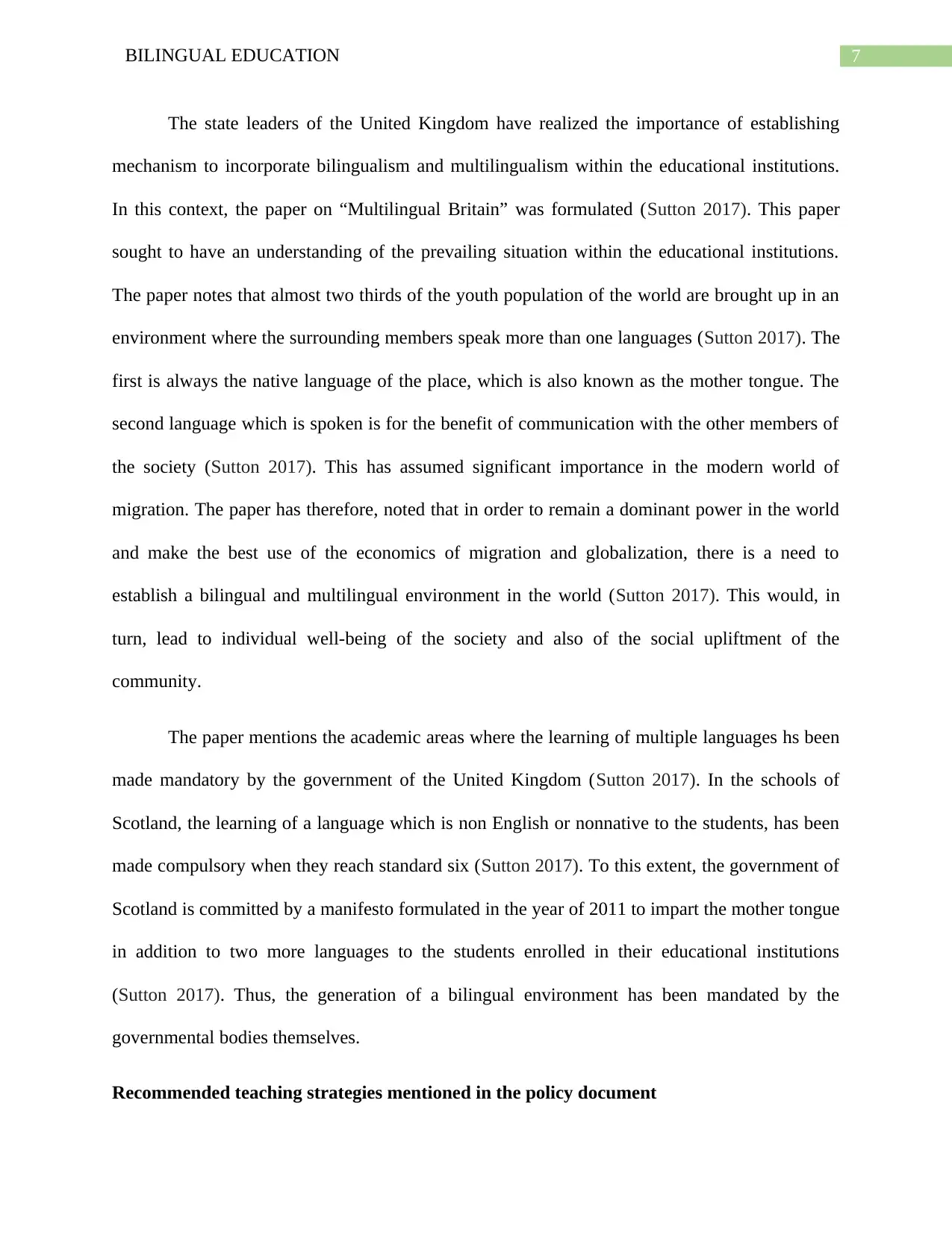
7BILINGUAL EDUCATION
The state leaders of the United Kingdom have realized the importance of establishing
mechanism to incorporate bilingualism and multilingualism within the educational institutions.
In this context, the paper on “Multilingual Britain” was formulated (Sutton 2017). This paper
sought to have an understanding of the prevailing situation within the educational institutions.
The paper notes that almost two thirds of the youth population of the world are brought up in an
environment where the surrounding members speak more than one languages (Sutton 2017). The
first is always the native language of the place, which is also known as the mother tongue. The
second language which is spoken is for the benefit of communication with the other members of
the society (Sutton 2017). This has assumed significant importance in the modern world of
migration. The paper has therefore, noted that in order to remain a dominant power in the world
and make the best use of the economics of migration and globalization, there is a need to
establish a bilingual and multilingual environment in the world (Sutton 2017). This would, in
turn, lead to individual well-being of the society and also of the social upliftment of the
community.
The paper mentions the academic areas where the learning of multiple languages hs been
made mandatory by the government of the United Kingdom (Sutton 2017). In the schools of
Scotland, the learning of a language which is non English or nonnative to the students, has been
made compulsory when they reach standard six (Sutton 2017). To this extent, the government of
Scotland is committed by a manifesto formulated in the year of 2011 to impart the mother tongue
in addition to two more languages to the students enrolled in their educational institutions
(Sutton 2017). Thus, the generation of a bilingual environment has been mandated by the
governmental bodies themselves.
Recommended teaching strategies mentioned in the policy document
The state leaders of the United Kingdom have realized the importance of establishing
mechanism to incorporate bilingualism and multilingualism within the educational institutions.
In this context, the paper on “Multilingual Britain” was formulated (Sutton 2017). This paper
sought to have an understanding of the prevailing situation within the educational institutions.
The paper notes that almost two thirds of the youth population of the world are brought up in an
environment where the surrounding members speak more than one languages (Sutton 2017). The
first is always the native language of the place, which is also known as the mother tongue. The
second language which is spoken is for the benefit of communication with the other members of
the society (Sutton 2017). This has assumed significant importance in the modern world of
migration. The paper has therefore, noted that in order to remain a dominant power in the world
and make the best use of the economics of migration and globalization, there is a need to
establish a bilingual and multilingual environment in the world (Sutton 2017). This would, in
turn, lead to individual well-being of the society and also of the social upliftment of the
community.
The paper mentions the academic areas where the learning of multiple languages hs been
made mandatory by the government of the United Kingdom (Sutton 2017). In the schools of
Scotland, the learning of a language which is non English or nonnative to the students, has been
made compulsory when they reach standard six (Sutton 2017). To this extent, the government of
Scotland is committed by a manifesto formulated in the year of 2011 to impart the mother tongue
in addition to two more languages to the students enrolled in their educational institutions
(Sutton 2017). Thus, the generation of a bilingual environment has been mandated by the
governmental bodies themselves.
Recommended teaching strategies mentioned in the policy document
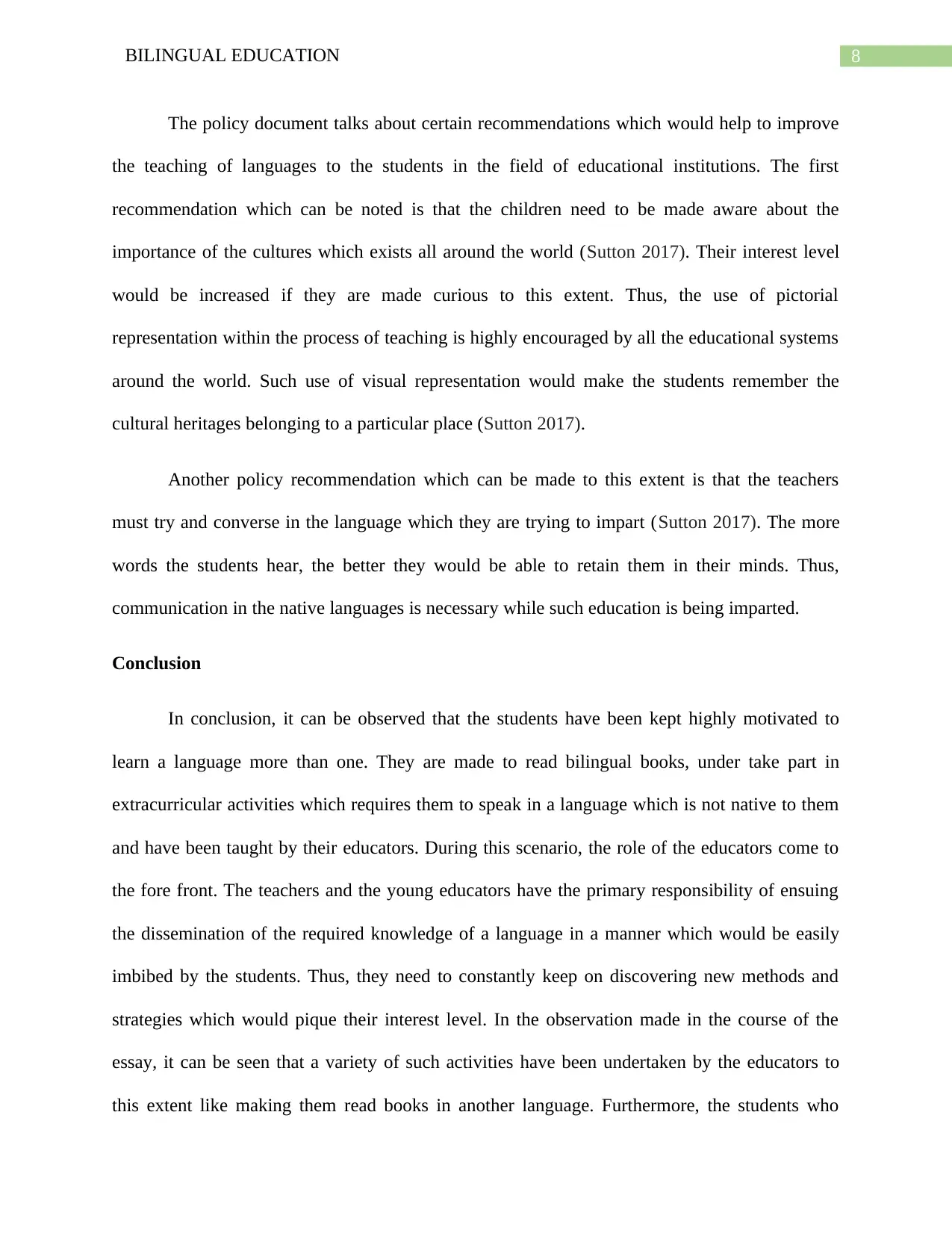
8BILINGUAL EDUCATION
The policy document talks about certain recommendations which would help to improve
the teaching of languages to the students in the field of educational institutions. The first
recommendation which can be noted is that the children need to be made aware about the
importance of the cultures which exists all around the world (Sutton 2017). Their interest level
would be increased if they are made curious to this extent. Thus, the use of pictorial
representation within the process of teaching is highly encouraged by all the educational systems
around the world. Such use of visual representation would make the students remember the
cultural heritages belonging to a particular place (Sutton 2017).
Another policy recommendation which can be made to this extent is that the teachers
must try and converse in the language which they are trying to impart (Sutton 2017). The more
words the students hear, the better they would be able to retain them in their minds. Thus,
communication in the native languages is necessary while such education is being imparted.
Conclusion
In conclusion, it can be observed that the students have been kept highly motivated to
learn a language more than one. They are made to read bilingual books, under take part in
extracurricular activities which requires them to speak in a language which is not native to them
and have been taught by their educators. During this scenario, the role of the educators come to
the fore front. The teachers and the young educators have the primary responsibility of ensuing
the dissemination of the required knowledge of a language in a manner which would be easily
imbibed by the students. Thus, they need to constantly keep on discovering new methods and
strategies which would pique their interest level. In the observation made in the course of the
essay, it can be seen that a variety of such activities have been undertaken by the educators to
this extent like making them read books in another language. Furthermore, the students who
The policy document talks about certain recommendations which would help to improve
the teaching of languages to the students in the field of educational institutions. The first
recommendation which can be noted is that the children need to be made aware about the
importance of the cultures which exists all around the world (Sutton 2017). Their interest level
would be increased if they are made curious to this extent. Thus, the use of pictorial
representation within the process of teaching is highly encouraged by all the educational systems
around the world. Such use of visual representation would make the students remember the
cultural heritages belonging to a particular place (Sutton 2017).
Another policy recommendation which can be made to this extent is that the teachers
must try and converse in the language which they are trying to impart (Sutton 2017). The more
words the students hear, the better they would be able to retain them in their minds. Thus,
communication in the native languages is necessary while such education is being imparted.
Conclusion
In conclusion, it can be observed that the students have been kept highly motivated to
learn a language more than one. They are made to read bilingual books, under take part in
extracurricular activities which requires them to speak in a language which is not native to them
and have been taught by their educators. During this scenario, the role of the educators come to
the fore front. The teachers and the young educators have the primary responsibility of ensuing
the dissemination of the required knowledge of a language in a manner which would be easily
imbibed by the students. Thus, they need to constantly keep on discovering new methods and
strategies which would pique their interest level. In the observation made in the course of the
essay, it can be seen that a variety of such activities have been undertaken by the educators to
this extent like making them read books in another language. Furthermore, the students who
⊘ This is a preview!⊘
Do you want full access?
Subscribe today to unlock all pages.

Trusted by 1+ million students worldwide
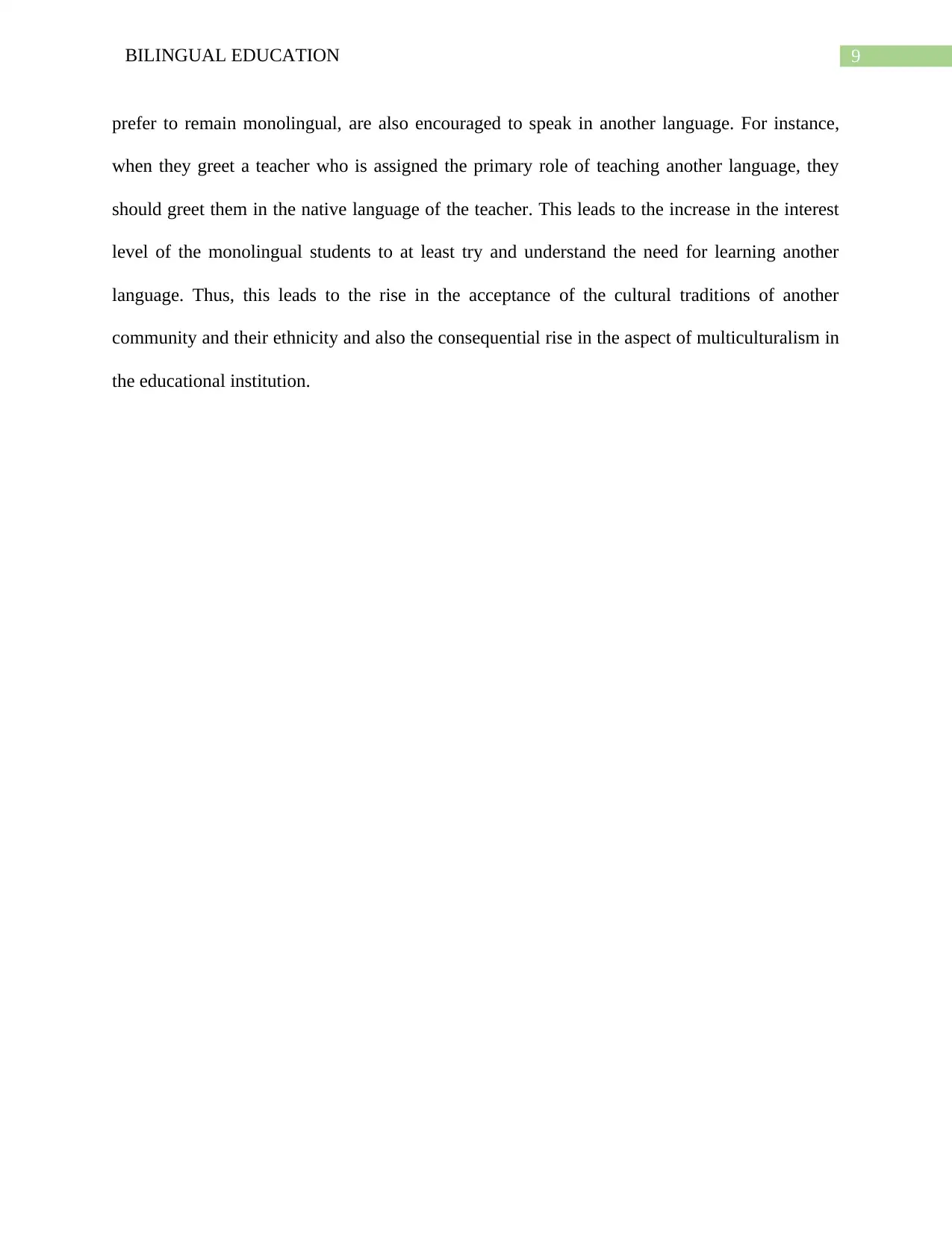
9BILINGUAL EDUCATION
prefer to remain monolingual, are also encouraged to speak in another language. For instance,
when they greet a teacher who is assigned the primary role of teaching another language, they
should greet them in the native language of the teacher. This leads to the increase in the interest
level of the monolingual students to at least try and understand the need for learning another
language. Thus, this leads to the rise in the acceptance of the cultural traditions of another
community and their ethnicity and also the consequential rise in the aspect of multiculturalism in
the educational institution.
prefer to remain monolingual, are also encouraged to speak in another language. For instance,
when they greet a teacher who is assigned the primary role of teaching another language, they
should greet them in the native language of the teacher. This leads to the increase in the interest
level of the monolingual students to at least try and understand the need for learning another
language. Thus, this leads to the rise in the acceptance of the cultural traditions of another
community and their ethnicity and also the consequential rise in the aspect of multiculturalism in
the educational institution.
Paraphrase This Document
Need a fresh take? Get an instant paraphrase of this document with our AI Paraphraser
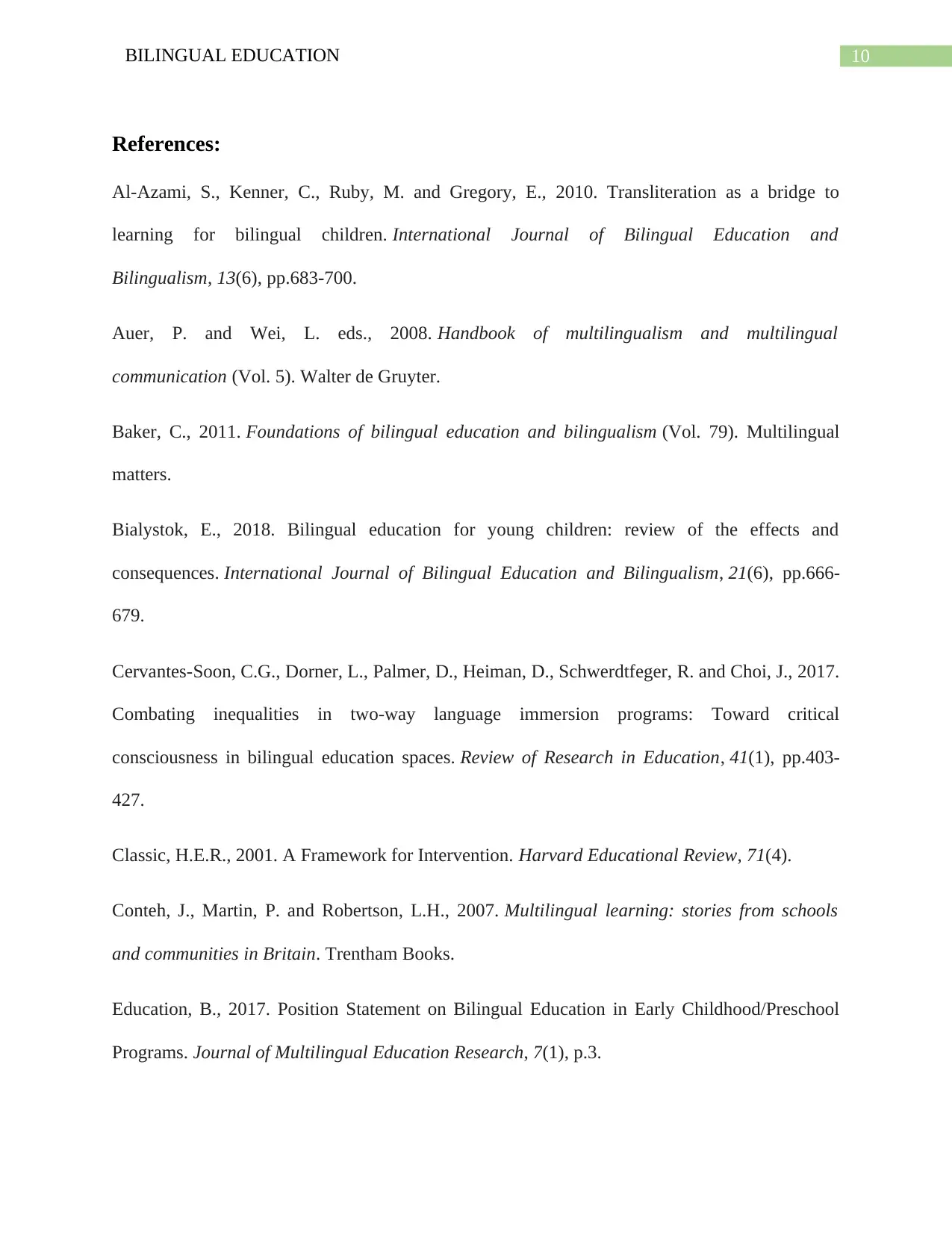
10BILINGUAL EDUCATION
References:
Al-Azami, S., Kenner, C., Ruby, M. and Gregory, E., 2010. Transliteration as a bridge to
learning for bilingual children. International Journal of Bilingual Education and
Bilingualism, 13(6), pp.683-700.
Auer, P. and Wei, L. eds., 2008. Handbook of multilingualism and multilingual
communication (Vol. 5). Walter de Gruyter.
Baker, C., 2011. Foundations of bilingual education and bilingualism (Vol. 79). Multilingual
matters.
Bialystok, E., 2018. Bilingual education for young children: review of the effects and
consequences. International Journal of Bilingual Education and Bilingualism, 21(6), pp.666-
679.
Cervantes-Soon, C.G., Dorner, L., Palmer, D., Heiman, D., Schwerdtfeger, R. and Choi, J., 2017.
Combating inequalities in two-way language immersion programs: Toward critical
consciousness in bilingual education spaces. Review of Research in Education, 41(1), pp.403-
427.
Classic, H.E.R., 2001. A Framework for Intervention. Harvard Educational Review, 71(4).
Conteh, J., Martin, P. and Robertson, L.H., 2007. Multilingual learning: stories from schools
and communities in Britain. Trentham Books.
Education, B., 2017. Position Statement on Bilingual Education in Early Childhood/Preschool
Programs. Journal of Multilingual Education Research, 7(1), p.3.
References:
Al-Azami, S., Kenner, C., Ruby, M. and Gregory, E., 2010. Transliteration as a bridge to
learning for bilingual children. International Journal of Bilingual Education and
Bilingualism, 13(6), pp.683-700.
Auer, P. and Wei, L. eds., 2008. Handbook of multilingualism and multilingual
communication (Vol. 5). Walter de Gruyter.
Baker, C., 2011. Foundations of bilingual education and bilingualism (Vol. 79). Multilingual
matters.
Bialystok, E., 2018. Bilingual education for young children: review of the effects and
consequences. International Journal of Bilingual Education and Bilingualism, 21(6), pp.666-
679.
Cervantes-Soon, C.G., Dorner, L., Palmer, D., Heiman, D., Schwerdtfeger, R. and Choi, J., 2017.
Combating inequalities in two-way language immersion programs: Toward critical
consciousness in bilingual education spaces. Review of Research in Education, 41(1), pp.403-
427.
Classic, H.E.R., 2001. A Framework for Intervention. Harvard Educational Review, 71(4).
Conteh, J., Martin, P. and Robertson, L.H., 2007. Multilingual learning: stories from schools
and communities in Britain. Trentham Books.
Education, B., 2017. Position Statement on Bilingual Education in Early Childhood/Preschool
Programs. Journal of Multilingual Education Research, 7(1), p.3.
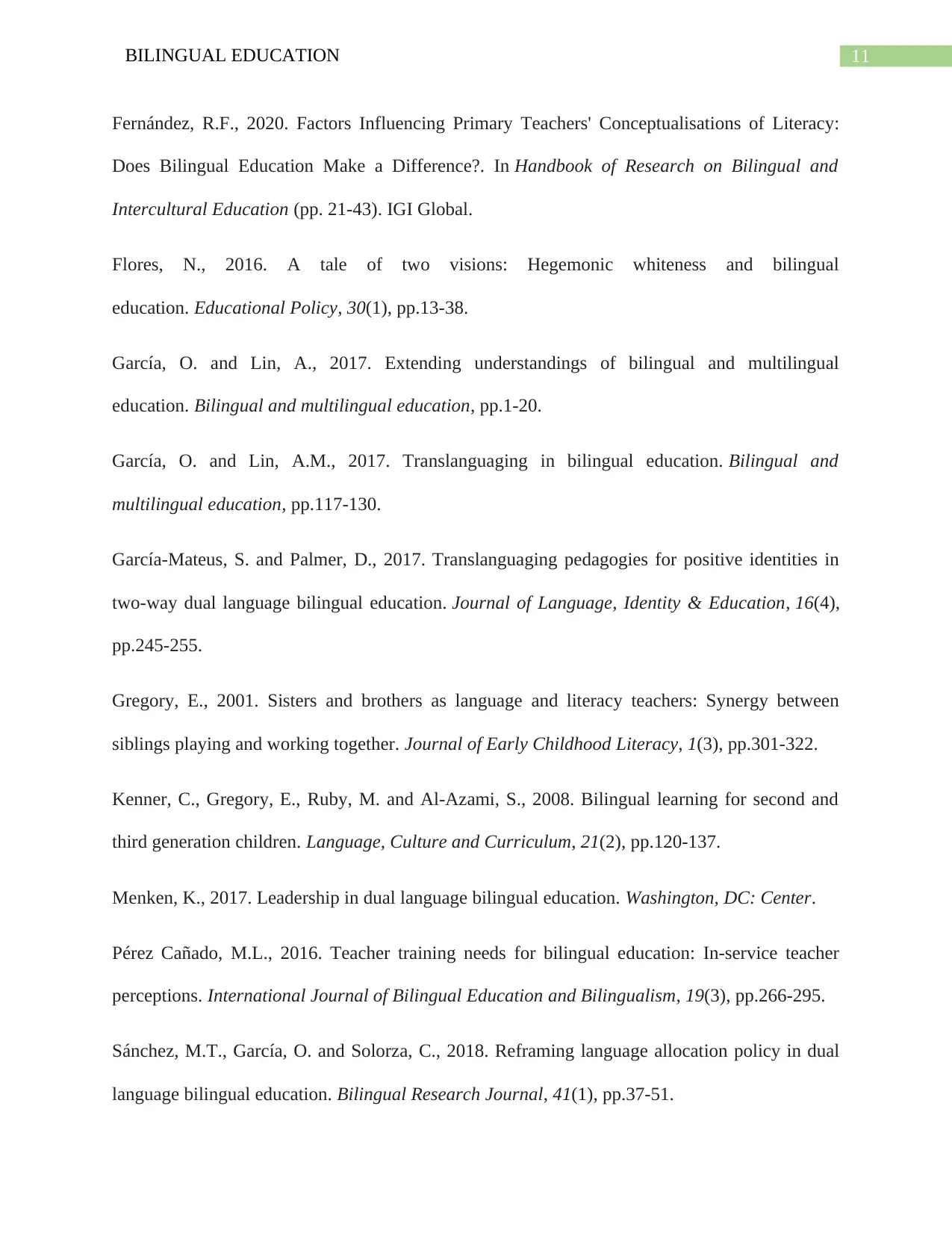
11BILINGUAL EDUCATION
Fernández, R.F., 2020. Factors Influencing Primary Teachers' Conceptualisations of Literacy:
Does Bilingual Education Make a Difference?. In Handbook of Research on Bilingual and
Intercultural Education (pp. 21-43). IGI Global.
Flores, N., 2016. A tale of two visions: Hegemonic whiteness and bilingual
education. Educational Policy, 30(1), pp.13-38.
García, O. and Lin, A., 2017. Extending understandings of bilingual and multilingual
education. Bilingual and multilingual education, pp.1-20.
García, O. and Lin, A.M., 2017. Translanguaging in bilingual education. Bilingual and
multilingual education, pp.117-130.
García-Mateus, S. and Palmer, D., 2017. Translanguaging pedagogies for positive identities in
two-way dual language bilingual education. Journal of Language, Identity & Education, 16(4),
pp.245-255.
Gregory, E., 2001. Sisters and brothers as language and literacy teachers: Synergy between
siblings playing and working together. Journal of Early Childhood Literacy, 1(3), pp.301-322.
Kenner, C., Gregory, E., Ruby, M. and Al-Azami, S., 2008. Bilingual learning for second and
third generation children. Language, Culture and Curriculum, 21(2), pp.120-137.
Menken, K., 2017. Leadership in dual language bilingual education. Washington, DC: Center.
Pérez Cañado, M.L., 2016. Teacher training needs for bilingual education: In-service teacher
perceptions. International Journal of Bilingual Education and Bilingualism, 19(3), pp.266-295.
Sánchez, M.T., García, O. and Solorza, C., 2018. Reframing language allocation policy in dual
language bilingual education. Bilingual Research Journal, 41(1), pp.37-51.
Fernández, R.F., 2020. Factors Influencing Primary Teachers' Conceptualisations of Literacy:
Does Bilingual Education Make a Difference?. In Handbook of Research on Bilingual and
Intercultural Education (pp. 21-43). IGI Global.
Flores, N., 2016. A tale of two visions: Hegemonic whiteness and bilingual
education. Educational Policy, 30(1), pp.13-38.
García, O. and Lin, A., 2017. Extending understandings of bilingual and multilingual
education. Bilingual and multilingual education, pp.1-20.
García, O. and Lin, A.M., 2017. Translanguaging in bilingual education. Bilingual and
multilingual education, pp.117-130.
García-Mateus, S. and Palmer, D., 2017. Translanguaging pedagogies for positive identities in
two-way dual language bilingual education. Journal of Language, Identity & Education, 16(4),
pp.245-255.
Gregory, E., 2001. Sisters and brothers as language and literacy teachers: Synergy between
siblings playing and working together. Journal of Early Childhood Literacy, 1(3), pp.301-322.
Kenner, C., Gregory, E., Ruby, M. and Al-Azami, S., 2008. Bilingual learning for second and
third generation children. Language, Culture and Curriculum, 21(2), pp.120-137.
Menken, K., 2017. Leadership in dual language bilingual education. Washington, DC: Center.
Pérez Cañado, M.L., 2016. Teacher training needs for bilingual education: In-service teacher
perceptions. International Journal of Bilingual Education and Bilingualism, 19(3), pp.266-295.
Sánchez, M.T., García, O. and Solorza, C., 2018. Reframing language allocation policy in dual
language bilingual education. Bilingual Research Journal, 41(1), pp.37-51.
⊘ This is a preview!⊘
Do you want full access?
Subscribe today to unlock all pages.

Trusted by 1+ million students worldwide
1 out of 15
Related Documents
Your All-in-One AI-Powered Toolkit for Academic Success.
+13062052269
info@desklib.com
Available 24*7 on WhatsApp / Email
![[object Object]](/_next/static/media/star-bottom.7253800d.svg)
Unlock your academic potential
Copyright © 2020–2025 A2Z Services. All Rights Reserved. Developed and managed by ZUCOL.





